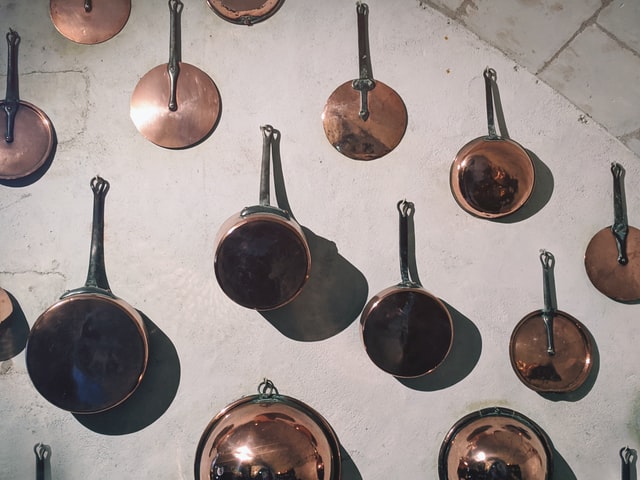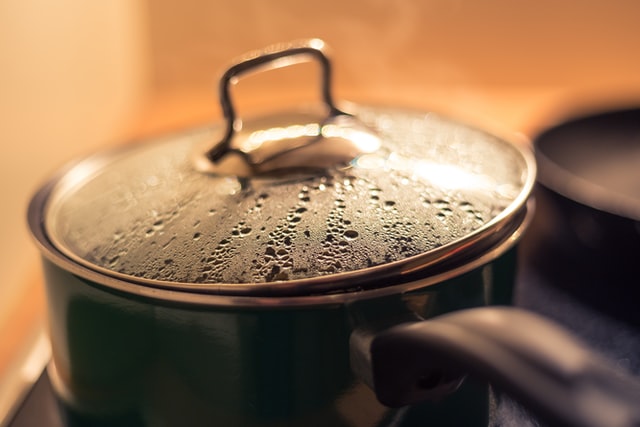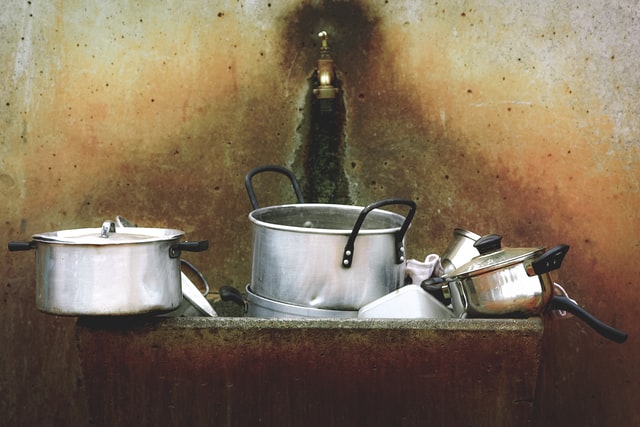Pots and pans come in all forms and sizes. It might be difficult to store, especially if you have a tiny kitchen. Cookware should ideally be housed around the range for ease when cooking, and you should be able to grasp the pan you need without having to rummage through a packed cabinet.
It’s difficult to discover the best places to keep them. You have a lot to think about, and it might be difficult to find something that works. Don’t worry, we’ve got a few suggestions for you to store them.
Ideas for Storing Pots and Pans in a Small Kitchen

⬤ Cabinet Organizer
Inside a kitchen cabinet is the most apparent location to keep pots and pans. A specialized pans cabinet may be made using one of these. Even in a 15-inch-wide cabinet.
This innovative organizer is a pan organizer shelf that glides in and out of the cabinet for convenient access.
The tension rods can sustain up to 100 pounds and are suited for a 15 to the 18-inch base cabinet. The fasteners you need are provided with the kit and are simple to install with just a screwdriver.
⬤ Pan Lid Organizer
It’s a fantastic concept for any little kitchen, and it also glides out of the cabinet in the same manner.
This practical manner of keeping pan lids, with a capacity of up to six, is another wonderful way to make the most of the cabinet space you currently have. Even in the smallest of kitchens.
⬤ Lazy Susan
If you have a corner cabinet that is difficult to access, a Lazy Susan organizer may be precisely what you need. As it turns out, even the stuff towards the rear is easily accessible.
It also includes two layers for pots and pans, so you may use one or both.
This Lazy Susan blind corner organizer may be installed on either the right or left side of a cabinet and rotates 360 degrees for easy access.
⬤ Heavy-Duty Pan Organizer
A pot organizer is one of the simplest and most cost-effective pan storage solutions. If you have any heavy objects, make sure to purchase a heavy-duty one so that the weight does not cause it to tumble over. On the lowest shelf, there’s even enough for a cast-iron Dutch oven.
⬤ Multi-purpose Pot Rack
If you’re not sure which manner to store pots will work finest for your area, you may experiment with three different arrangements. It may be configured as a single stacking shelf or one with potholders on both sides.
Alternatively, you may use it as a dish drying rack by laying it on its side. This has several nice features to recommend, such as silicone grips to keep pots in place, an anti-rust covering, and eight movable dividers to arrange the shelves any way you choose.
This implies you can make customizable tiers to accommodate different pot sizes.
⬤ Under Sink Kitchen Organizer
Cleaning supplies aren’t the only things to keep beneath the sink; because they’re smaller than pans, they may easily be stored elsewhere. It is ideal for any little homeowner or tenant looking for a place to store their pots and pans.
⬤ Pull-out Pot Rack
The pull-pot pan rack may make excellent use of available space within a kitchen cabinet. It consists of a pull-out bar that holds several hooks, from which your pots may be hung. With the ability to support an amazing 150 pounds of cookware, this gives a home for even the largest cast iron pots.
⬤ The Pan And Lid Organizer
This excellent pot and lid organizer is quite useful. This non-slip kitchen storage resolution includes ten non-scratch partitions for pans and lids.
There is no requirement for installation, and you may use this lid and pan holder on the counter, inside a cabinet, or on a shelf. There is also a tiny standard size available.
⬤ Single Bar Ceiling Pot Rack
Rather than utilizing your restricted floor or cupboard space, hang your pots from the awning to make the most of some space. If you choose, this ceiling rack may easily be wall installed. It’s simple to put together, and more hooks may be purchased separately if needed.
⬤ Kitchen Pegboard
These may be used to hang a variety of objects, ranging from small tools that clutter up your kitchen drawers to larger items such as pots and pans.
Wall Control pegboards come in various colors to match your décor and are up to ten times stronger than the typical equivalent product.
Types of Cookware Materials

➤ Aluminum
Aluminum is the most often used material in cookware. It’s a great heat conductor and distributes heat evenly around the pan. If aluminum is the ticker, heat distribution is even greater.
To harden the aluminum, it can be anodized. Hard-anodized cookware is better than steel and lasts far longer. It’s also dishwasher safe. In addition, as compared to other materials, this sort of cookware is quite affordable.
The disadvantage is that untreated aluminum is more prone to discoloration and interaction with foods. As a result, we choose aluminum with a nonstick interior since it is less prone to discolor or react with foods.
➤ Cast Iron
It is extremely dense and strong. Even though it takes longer to warm up, it maintains and spreads heat evenly. This is a perfect choice if you enjoy browning and baking.
When it comes to cast iron skillet care, there are a few factors to keep in mind. To begin, cast iron skillets should never be soaked in water or left to dry after washing. This is because cast iron skillets may rust if left in water for a lengthy time.
➤ Copper
Copper is the finest heat conductor. It’s ideal for cooking on top of a stove if you need to manage the temperature. The most significant downside of utilizing copper is the cost of upkeep.
Copper may discolor, therefore you should polish it now and again to erase the stains. Copper is also apt to dent and scratch.
➤ Nonstick
The Nonstick cookware has a layer within the pan that prevents food from sticking to it. This makes it incredibly simple to prepare low-fat, healthful meals.
It’s really easy to clean since food doesn’t attach to it. It can be found in conjunction with a variety of metals used to make cookware. This sort of cookware has the problem of being readily scratched.
➤ Stainless Steel
Stainless steel is an excellent all-purpose cookware material. It’s lightweight, long-lasting, and simple to clean. It is, nevertheless, a poor heat conductor, thus many stainless steel elements have a copper or aluminum disc in the bottom to assist spread heat more evenly.
➤ Carbon Steel
Carbon steel is utilized in both high-end cookware and low-cost cookware. It is maintained in the same way as to cast iron, although it is substantially lighter in weight.
And because it holds its temperature effectively, it is ideal for cookery that requires rapid temperature changes.
➤ Ceramic
Since ceramic cookware is an excellent insulator, it does not react fast to heat. It is often available in the shape of a casserole dish or other forms that are ideal for slow cooking at a steady temperature. It is more lightweight than cast iron, but it is more brittle.
➤ Porcelain
Porcelain is heated to make it extremely hard. Though porcelain is often thought to be fragile, it may be rather resilient. It is also commonly utilized on the stove, in the oven, and in microwaves. Porcelain is often white because it helps to highlight details.
How to Clean your Pots and Pans Based on their Materials

Cookware should endure for years if properly cared for. However, it is essential to keep the material from which it is manufactured in mind.
─ Aluminum
To avoid pitting, wash as soon as feasible after usage and completely dry. Aluminum tarnishes rapidly, so polish the surfaces with a non-scratch scouring pad.
─ Cast Iron
Before utilizing cast-iron cookware, season it. Brush the edges of a pot with unflavored vegetable oil before adding sufficient oil to fill the bottom.
Cook for one hour at a low temperature in the oven. Draw it from the oven, allow it to cool, then pour out the oil and brush away any debris with a paper towel. To avoid rusting, wash with hot water and dishwashing solutions after each use and thoroughly dry.
If there are any rust marks, scrub them with steel wool and a little oil.
─ Copper
Rather than scrubbing, which can damage the tin lining, clean pots, and pans with warm water and dishwashing solutions, then bathe in the same solution if required, to terminate baked-on food.
Clean the outside of the cookware using a white vinegar and salt solution, then rinse and polish. Alternatively, a commercial copper cleaning can be used.
─ Enamel
Aluminum, cast-iron, or pressed-steel pans and baking dishes with enamel coating can be hand cleaned. To avoid scratching, avoid using abrasive cleaners and scrub pads.
─ Nonstick
Examine the care directions. Most are not intended to be washed in the dishwasher but may be washed with hot water and dishwashing solutions.
─ Stainless steel
To prevent the possibility of discoloration, wash stainless steel with soap and water as soon as feasible after use. Avoid using scouring powder or steel wool, which can scrape surfaces and leave them vulnerable to staining.
So avoid soaking stainless-steel pans for lengthy periods, since mineral salts in the water can cause them to pit.
Several Types of Pots and Pans

When searching for new cookware, the first factor you should consider is the many sorts of pieces that are available. If you are a novice, you will most likely want efficient and affordable cookware options.
˃ The Stock Pot
The Stockpot is a huge, deep, flat-bottomed pot. It is used to prepare liquid items that do not require being near the heat source.
Stockpots permit you to sauté or brown food before adding liquids to make stocks, soups, or stews. Their large profiles are ideal for keeping pasta immersed during the cooking process.
This pot comes in a spectrum of sizes, and it’s essential to remember that having various sizes comes in helpful when cooking for a little or big company.
˃ The Fry Pan
A fry pan or skillet is a kitchen workhorse and one of the most adaptable elements of cookware you’ll ever possess. With the correct fry pan, you can easily flip omelets, stir-fry vegetables, and even sear meats.
These pans have a flat bottom and curved edges, creating them ideal for flipping meals over or simmering with oils. The temperature of your pan is determined by the material it is made of.
Nonstick pans should not be heated over low or medium heat to keep their coating, whereas stainless steel may be heated to high temperatures. Frypans and skillets come in various sizes and normally do not have a cover.
˃ The Cast Iron Skillet
Cast Iron Skillets are another type of skillet. Cast iron skillets are identical to fry pans, but the primary distinction is how they should be cared for and the material they are composed of.
And because they are constructed of cast iron, these skillets may be rather hefty. If you’ve never used a skillet before, the best suggestion is to come in and handle one before purchasing.
When purchasing a Cast Iron Skillet, make sure it is preseasoned. The issue with non-seasoned skillets is that food will stick to them.
˃ The Sauté Pan
The Sauté Pan is designed for sautéing, which means it can cook food while moving it about fast in the pan while covered with a lid.
When it comes to innovation, sauté pans are equivalent to fry pans in that they both have a flat bottom. However, the key distinction between fry and sauté pans are that sauté pans have straight edges rather than rounded sides.
Since they are deeper than a frying pan, sauté pans may be used for more than just sautéing. Some of these applications include deep-frying, searing, and creating sauces.
˃ Thee Sauce Pan
The base of the Sauce Pan is circular, while the sides are tall and straight. This means they are a very adaptable cookware option that can be used to make a mixture of sauces and soups.
Saucepans are a must-have in any kitchen since they may be used with or without a cover to control evaporation. A saucepan is also utilized for a variety of other tasks.
˃ The Braiser Pan
Braiser pans, also known as Braisers, are huge, flat-bottomed pans with a moisture-locking cover. The Braiser Pan’s structure makes it a multitasker as well as a superb addition to any collection.
They can brown food on the cooktop. Some braiser pans are even created to be served directly from the pan.
˃ The Grill Pan
A griddle is a big piece of cookware with a flat or ridged surface. It may be utilized to prepare breakfast items like pancakes, hash browns, and eggs with minimal oil.
It can be square or circular, although it often lacks the extended handle of a frying pan. Griddles and grill pans with a slightly ridged surface are ideal for creating those perfect grill marks.
˃ The Wok
Woks are a popular all-purpose Asian pan with high, sloping edges. Traditionally, they are 14 inches in diameter and comprised of carbon steel.
These pans have a heated cooking surface on the base and a cooled cooking surface on the sides. Furthermore, the ability to move the components about the pan provides considerable control and adaptability over the temperature. Woks work well for stir-frying, steaming, and deep-frying.
˃ The Roasting Pan
A roaster is a big rectangular pan with low sides that allow the heat from the oven to reach as much of the food as feasible. Roasting pans are frequently used in conjunction with a roasting rack, which elevates food over the cooking surface.
It works well in the dry heat of the oven at rather high temperatures. This is a must-have pan for roasting turkeys and other types of roasts.
˃ The Dutch Oven
The Dutch Oven is a bigger pot meant for slow-cooking huge quantities of stews or pot roast. Dutch ovens are commonly circular and constructed of cast iron.
Most Dutch ovens include a pair of small handles for safe and simple lifting. Dutch ovens are available in several hues, which many chefs like since they offer a pop of color to any cookware set.
Frequently Asked Questions
Q: Can I keep pots and pans in the sink?
A: Yes, as long as they are covered by a plastic or sealed container.
Q: How should a mixing bowl be stored?
A: Mixing bowls should be stored together, nested, in the cabinet closest to where you perform your prep work.
Q: Is it permissible to stack pots and pans?
A: You may still stack your pans as long as you put a layer of protection between them.
Q: How do you use a lazy Susan to store pots and pans?
A: You may conceal them in a cabinet corner.
Q: What is the purpose of pots and pans?
A: A wide range of cookware used for all aspects of food preparation, including boiling, frying, sautéing, baking, broiling, and roasting.
Final Thoughts
There are several simple measures you may take to make extra room in your tiny kitchen for all of your pots and pans.
Investing in the correct kitchen storage solutions, whether it’s a pull-out shelf liner to accommodate more items within your current cabinets or making the most of underutilized wall and ceiling space, maybe a game-changer.
